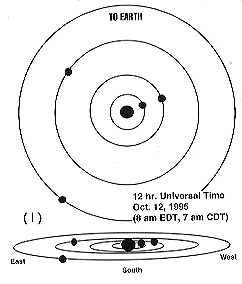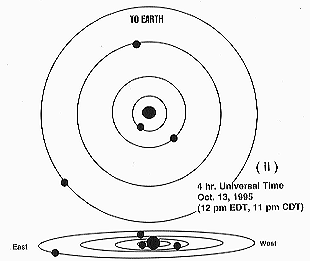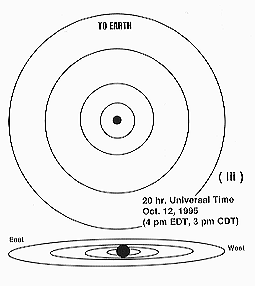


 Jupiter has 4 large moons which can be seen witha binoculars (and even with the naked eye if the night is just right).
Jupiter has 4 large moons which can be seen witha binoculars (and even with the naked eye if the night is just right).
The KAO observes Jupiter and its moons during the daytime on October 12, 1995.
The astronomer operating telescope will be able to see Jupiter through the
telescope, but maybe not the moons. The IR detector, however, wll 'see' the
moons in infrared where they are brighter than the surrounding sky.
The order of moons outward from Jupiter is Io, Europa, Ganymede, and Callisto.
These moons are in constant orbital motion around Jupiter --each moving at its own
speed based upon its distance from Jupiter. (i) and (ii) show the locations of
the moons before -and after the KAO flight.
 The KAO begins observing Jupiter's moons -around 16:00 hrs--4 p.m. EDT on October
12, 1995. On figure (iii), draw where the moons will be at 16:00. EDT (20 hr.
UT) just before the observing run begins. (HINT)-. This time is halfway between
where the moons were at 12 hr. UT on Oct 12 and where they will be at 4 hr. UT
Oct 13)
The KAO begins observing Jupiter's moons -around 16:00 hrs--4 p.m. EDT on October
12, 1995. On figure (iii), draw where the moons will be at 16:00. EDT (20 hr.
UT) just before the observing run begins. (HINT)-. This time is halfway between
where the moons were at 12 hr. UT on Oct 12 and where they will be at 4 hr. UT
Oct 13)
![]()